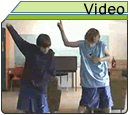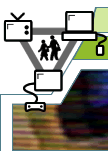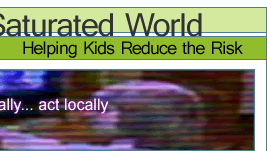 |
 |
 |
 |
 |
| Parents |
|
Recognizing that parents play a major role in the lives of
children we seek to include parental participation and education
as part of the Media Risk Reduction Intervention. Parents
along with other community assets have been known to support
risk communication as well as reduction, therefore it became
imperative to develop the program with not only the students
and teachers in mind, but also the parents and the child's
home environment. This is evident in a number of lesson plans
which have included media diaries for parents, media surveys,
child directed interviews with parents and other homework
assignments that encourage the child to discuss media with
their parents at home.
Power Point presentation
discussion the Politics of Hope
Community
Mobilization Against the Risks of Violent Entertainment?
|
| Another role of the Media Analysis
Lab is to educate others about 'Kid Culture'. Over the summer
we had 60 students at Simon Fraser University examine popular
books, video games, toys, movies and televisions shows as
a mean for them to become familiar with youth culture today
and apply their knowledge of communication theory to these
products. Many of the student succeeded in producing excellent
summaries and analysis of these products. These reviews will
soon be available for you to examine and maybe use in your
attempt to monitor and provide cultural products for your
children.
click here
for cultural product reviews
|
| |
| |
Week 1: Media Diaries
This first week allowed the students to get to know the researchers
from SFU by expressing their preferences for certain television
programmes, video game and computer related activities. The
aim was to make the children feel comforable enought to speak
freely about their media use patterns. We then asked them
to fill out a week long media diary asking how long they spent
with media and what shows, games and computer related activities
they engaged in. On the last day of the week we came back
to the school and conducted a media math lesson,
which asked the students to add up all their media use for
the week. This approach allowed the students to see for themselves
the amount of media they used, rather than being told they
watch just enough or too much, they made their own judgments.
Most of the students did however, decide they spent too much
time with the media and the project allowed the students to
direct their future decisions based on their own empirical
evidence from their own survey data.
|
| Top |
Week 2:
Heroes/heroines |
This lesson will deal with the differences between
real and fictional heroes and heroines. We want the children
to examine the stereotypical characteristics of heroes and heroines
in the media. A work sheet will allow the students to describe
the characteristics of their favorite book character, TV show
and video game characters. They will then discuss these characteristics
with a partner and come up with a table of characteristics,
which they will then have to place a real and fictional hero/heroines
name. The groups will then share with the class.
Following the class discussion of characteristics of real and
fictional heroes and heroines the class will be asked to think
about why TV and video game producers use such characteristics
and why we find them so appealing. We will then discuss how
possible it is to 'fly over buildings', fight and never get
hurt, always win, etc. that seem to follow the traits of fictional
heroes and how us as viewers must question what is going on
and what is real versus a technological trick.
( Two of the four school will also take part in a media debunking
activity. Media specialists from Simon Fraser University Media
Analysis Lab will be coming to the school and setting up a demonstration.
This demo will entail a student meeting their favorite cartoon
character or standing in their favorite TV show scene via technology
such as a blue screen, video camera and Television. The objective
of this particular activity is to show the students how easy
it is to manipulate scenes, images and locations via video technology.
We hope that this will not only provide a fun experience, but
also allow the students to continually questions what they see
on the media).
The object of this lesson is to get children to question stereotypes
and the images of heroes and heroines in the media.
|
|
| Top |
Week 3:
Scripting and Re-Scripting |
This lesson will continue the discussion from
the previous week on stereotypes in the media and will broaden
to include the stereotypes of bully, victim and bystander. We
will discuss stereotypes of bullies, victims and bystanders
in the media and ask the children why they think this happens.
We will then bring in a video clip from a show the students
have chosen as one of their favorites and edit it down to examine
a particular scene which illustrates either stereotyping of
a character or describes a potential bullying scenerio. We will
then stop the programme and ask the children to decide the best
way to deal with the incident. We will also ask them to take
different perspectives and tell us how a bully, victim and bystander
would stereotypically handle the situation in the media and
the problems of the character handling it in an improper way.
The short video production will be followed by a discussion
of show and game genres and what makes these show a drama, comedy
or sports show. This will be followed by a short content analysis
worksheet which will be used to help children examine elements
in a show rather than becoming a media zombie or 'zone out'.
The objective of this project is to show the children that they
can deconstruct a show and questions elements of the show in
a critical and educated manner.
|
|
| Top |
Week 4:
Moral Education |
This lesson is used to help promote non-media
activities in preparation for Tune Out week. We will talk to
the children about favorite school yard games and favorite games
of their parents to help build the non-media related gaming
repertoire of the students. We will also ask the children what
happens when they are playing a game and someone breaks the
rules. This will lead in to a discussion of fair and just play.
This understanding that rules need to be meet and continually
understood will allow them to develop their own game, complete
with rules and regulation. Objects from the school's gym storage
room will be used and the children will be asked to develop
a game and share their development with the class.
This lesson plan has two main objectives. The first objective
is to discuss alternatives to the media. If we can interest
them in games and other non-media related activities they may
find the Tune out week easier. The second objective is to discuss
the importance of play and the importance of learning boundaries
and rules and learning to develop a sense of how games are played
in a fair and just manner.
|
|
| Top |
Week 5:
Tune out preparation Week |
This week's lesson will be spent brainstorming
non-media related activities for the students to do while they
are taking part in media Tune Out week. Art projects such as
making banners, posters, and possibly T-Shirts will help get
the children excited about participating in a unique activity.
( The remain two of the four school will also take part in a
media debunking activity. Media specialists from Simon Fraser
University Media Analysis Lab will be coming to the school and
setting up a demonstration. This demo will entail a student
meeting their favorite cartoon character or standing in their
favorite TV show scene via technology such as a blue screen,
video camera and Television. The objective of this particular
activity is to show the students how easy it is to manipulate
scenes, images and locations via video technology. We hope that
this will not only provide a fun experience, but also allow
the students to continually questions what they see on the media). |
|
| Top |
Week 6:
Media Tune Out Week |
| This will be the last week we will be in the
classrooms. This lesson will act as both a wrap up and a reinforcement
of the student's participation in the tune out week. We will
initially hand out non-media diaries for the week and on the
Friday will ask how the week was and get the student's reactions
to the program as a whole. This may take the form of a written
critique of the project or a art project of what they did while
Tuning out to the media for a week. |
|
| Top |
Week 7:
Family Interviews |
In order to assess the success of this project
we would appreciate any feedback from families. We would like
to set up interviews at the family's home, the school or at
the SFU media lab to have parents and children express their
opinions of the project, media and the Tune Out Week experience.
This is an important part of the project because it will allow
us to fully understand the problems and successes of the family
in reducing their media usage.
|
|
|
 |
 |
 |
 |
|

| |
|

To learn about this Risk Reduction Strategy watch this video |
|

Watch this video to learn about teachers' experiences of the project
|
| |
|





